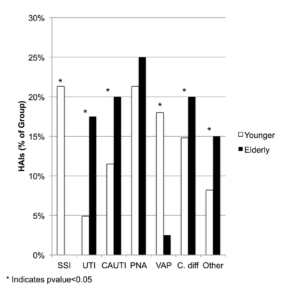Healthcare-Associated Infections (HAIs) in Elderly Trauma Patients
Author(s):
Jennifer Rickard; Jonathan Gipson; Patty Reicks; Melissa Thorson; Carol Schnack; Michaela West
Background:
Increased morbidity, mortality, and cost have been linked to healthcare-associated infections (HAIs). Little is known about HAIs or their outcomes in elderly patients.
Hypothesis:
We hypothesized that elderly trauma patients would have more HAIs compared to younger trauma patients.
Methods:
A trauma registry was used to find all trauma patients with HAIs at a level I trauma center from 1/15 to 12/16. Retrospective analysis of HAIs was performed including: surgical site infection (SSI), urinary tract infection (UTI), catheter-associated UTI (CAUTI), pneumonia (PNA), ventilator-associated PNA (VAP), and Clostridium difficile (C. diff) infection. Age, injury severity score (ISS), length of stay (LOS), death, and infections were compared between elderly (>=65 years) and younger patients using Chi square and students ttest for categorical and continuous variables, respectively.
Results:
The study population consisted of 5228 trauma patients, with 2036 (39%) elderly and 3192 (61%) younger patients. A total of 101 (1.93%) HAIs were found, with a similar proportion in older and younger cohorts (1.96% vs. 1.91%, respectively, p = 0.90).
In patients with HAIs, the mean ISS was 24.3 with lower ISS in elderly patients (15.7 vs. 24.4, p<0.05). The mean LOS was 23.9 days, with shorter duration in elderly patients (14.2 vs. 22.9 days, p <0.05). There were 3 deaths, with all deaths occurring in elderly patients (p=0.030).
The table compares HAIs by age group.

Conclusions:
Overall incidence of HAIs is low in this trauma population. There was no difference in overall rates of HAIs in elderly versus younger trauma patients, but we observed a significant difference in the type of HAIs seen. CAUTIs were seen more often in elderly patients whereas younger patients developed more SSIs and VAP.

